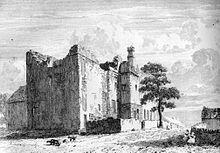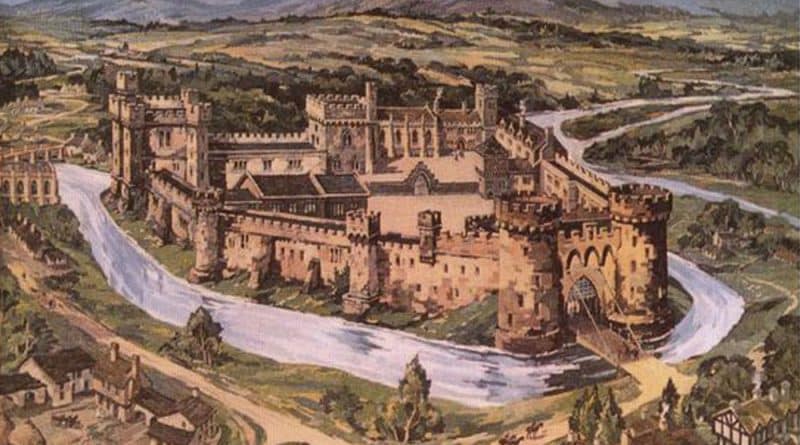Sheffield Castle
Sheffield Castle was built adjacent to the confluence of the Rivers Sheaf and Don in what is now Sheffield City Centre. The site may originally have housed a Saxon Hall though this is far from certain. A Norman Motte and Bailey Castle was constructed following the ‘harrying of the north’. This castle was destroyed in 1266 during the rebellion led by Simon de Montfort. Following this, a licence to crenallate a stone castle at Sheffield was granted to Thomas De Furnival in 1270. The castle remained important throughout the Medieval Era.
In 1648 the castle was demolished on the orders of Parliament as a result of it having resisted Parliamentary forces in 1644. Other notable people linked to Sheffield Castle are Earl Waltheof, the Saxon Lord of Hallamshire, the Neville Family, the Talbot Earls of Shrewsbury and Mary Queen of Scots who was held at the castle for 14 years.
Origins
The Domesday book notes that at the time of the Norman Invasion Sheffield had been held by Earl Waltheof and that he had a large hall in the town. The site of the later castle is one of the places that are considered likely sites of this hall, as the Normans often utilised existing structures when constructing their Motte and Bailey Castles. It would be likely that there was at least some consideration to defence at the site given it overlooks the confluence of two rivers which were of importance to the regional economy and navigable by economic and military orientated vessels.
Motte and Bailey Castle in Sheffield
Sheffield had been held by Earl Waltheof, a Saxon noble who had rebelled against Norman rule eearly in the Conquerors reign. It was his rebellion that led to the ‘harrying of the north’ and as Sheffield was one of his major land holdings, it was somewhere that the Normans would want to dominate and control as soon as possible. There is no clear date for the construction of the first Motte and Bailey in Sheffield. The first Norman lord to hold the manor was Roger de Buisli who held Sheffield from Judith, wife of Walteof.. His estates, in general, passed to Robert de Bellesme.
The manor passed to William De Lovetot c1120 with evidence suggesting he held it from Maud, a daughter of Earl Walteof and Judith. We know that de Bellesme fortified Tickhill, and that de Lovetot built a bridge over the River Don and a Church within Sheffield. Which of the men was responsible for constructing the castle in Sheffield is not entirely clear. What is known is that a fortification of Motte and Bailey design was in place by 1180 when Sheffield was held by the De Furnival famly. This is evidenced through letters sent by King John which allude to a castle in Sheffield.
1266: Sheffield Castle destroyed
In 1266 Sheffield was held by the De Furnival family following the marriage of heiress Maud de Lovetot to Gerard de Furnival in 1204. When Simon de Montfort Earl of Leicester rebelled, the castle was attacked by Baron D’Eyvill and destroyed. This action is evidenced through archaeological finds which include a layer of demolition rubble from that period. Following the end of de Montfort’s rebellion, Thomas De Furnival was granted a licence to crenallate a Castle in Sheffield. This licence was issued in 1270. As a result, a large stone castle was built in Sheffield on the site of the Motte and Bailey.
The fifteenth century
The Castle passed from the de Furnival family to the Fauconburg branch of the Neville family. The Neville’s held Sheffield briefly, with it then being passed into the hands of John Talbot, 1stt Earl of Shrewsbury. His family then held the castle for many generations.
In 1460 John Talbot 2nd Earl of Shrewsbury, who had been born at Sheffield Castle, fought in the Lancastrian army at the Battle of Northampton. He was one of the nobles who was killed in this battle. The 3rd Earl of Shrewsbury was only 12 years old when his father was killed in battle. However, he was present at the Second Battle of St. Albans, being knighted after the Lancastrian victory. He was also at or close to the Battle of Towton which resulted in a Lancastrian defeat and the transfer of power to the Yorkists.
As the 3rd Earl matured he was appointed Commissioner of Oyer and Terminer for Yorkshire, Cumberland, Westmorland and the City of York in 1469 followed by appointment to the same role in Shropshire in 1470. In September 1471 John 3rd Earl of Shrewsbury was appointed as chief justice of North Wales and entrusted with a commission to treat with Scotland in 1472 and again in 1473.
Sources about Sheffield Castle
ye scite of ye Mannor or Mansion house called Sheffeild Castle being fairely built with stone & very spacious containeth divers buildings & Lodgings about an Inward Court yard & all offices thereto belonging having a Great Ditch about ye same ye Great River of Doun lying on ye north parte thereof & ye Lesser River called ye Little Sheath on ye East parte thereof haveing on ye South an outward Court Yard or fould builded round with diverse houses of office as an armory a Granary, Barnes Stables & divers Lodgeings all containeing by measure 4 acres 00 roods 30 2/5 perches
John Harrison’s 1637 ‘Exact and Perfect Survey and View of the Manor of Sheffield
Deer Park and Lodge
As a major castle housing senior noble families, Sheffield Castle should not be seen in isolation. As well as the 4 acre site of the castle, the various custodians of the site constructed other buildings within Sheffield and had facilities for hunting. A Deer Park was relatively close to Sheffield Castle, for example. George Talbt, 4th Earl of Shrewsbury, built Sheffield Manor Lodge in 1515 to provide additional comfortable accomodation for his family near the Deer Park.

Reconstruction of Sheffield Castle
Digital recreation of Sheffield Castle. By the University of Sheffield, via Youtube.
Open Access Book about Sheffield Castle
White Rose University Press have published Sheffield Castle: Archaeology, Archives, Regeneration, 1927–2018 by John Moreland and Dawn Hadley. It is a detailed book looking at the history and archaeology of the site. It is available free of charge in digital format.
Other Castles in South Yorkshire
Sheffield Castle Links
Historic England – official listing for the remains of Sheffield Castle. Note, this is a very limited listing. Further information in the links below.
Friends of Sheffield Castle – archaeology, history, and future of Sheffield Castle.
Yorkshire.com – covers the history of the Castle along with information about archaeological work being done at the site.
University of Sheffield – Hidden history: Rebuilding Sheffield Castle. Video and digital reconstruction.
Sheffield City Council – pdf version of a presentation on the history of Sheffield Castle.
Archaeological Research Services – overview of Sheffield Castle’s history and proposals for the archaeological work being undertaken at the site.
1066 – Brief history of Sheffield Castle.
Featured Image
A drawing of Sheffield Castle by Kenneth Steel (1950)
